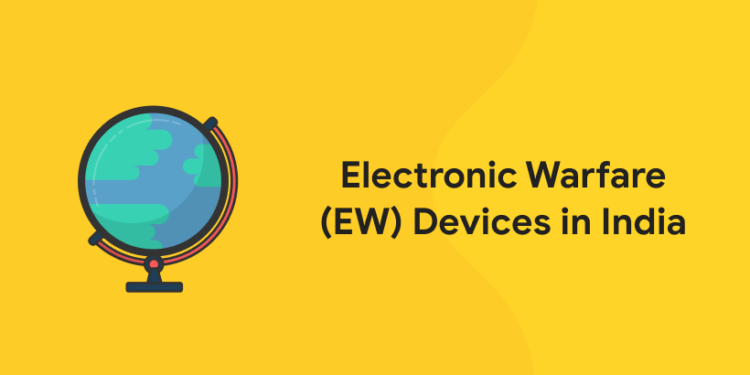Table of Contents
Electronic Warfare (EW) is the use of electromagnetic or directed energy and integrated cyber capabilities to carry out military and intelligence missions. The more demands a military force exploits the full electromagnetic (EM) spectrum – radio waves, microwaves, millimeter waves, infrared, visible light, ultraviolet light, and gamma rays – and cyber effects, the more successfully it can pre-empt adversarial threats and respond to attacks electronically.
EW devices broadly include radars, transmitters, antennas, sensors and communication devices – the Forces “ears and eyes “for detecting enemy presence or deter its intelligence-gathering.
Attempt Free GK Mock test ! Download Entri App!
Electronic Warfare device
- Electronic warfare devices are basically warfare equipment that uses the electromagnetic spectrum for sensing, protecting and communicating.
- Signals like radio, radar or infrared are used in these warfare devices.
- Electronic warfare allows the user to target not only communication radar but also other military and civilian assets.
- The purpose of electronic warfare is to deny the opponent the advantage of, and ensure friendly unimpeded access to, the EM spectrum.
- Electronic warfare device is used for collecting information from the enemy’s radio signal or detecting an incoming missile from radar.
- EW can be applied from air, sea, land, and/or space by manned and unmanned systems, and can target humans, communications, radar, or other assets.
- EW includes the use of Radio Waves or Laser Light beams.
EW Devices are defined as devices that assist and are used for electronic warfare. Electronic Warfare devices mainly subdivided into three based on their functions,
- Electronic Warfare Attack
- Electronic Warfare Protection
- Electronic Warfare Support
Electronic Warfare Attack
- Electronic Warfare attack (EWA), or electronic countermeasures (ECM)) involves the offensive use of EM energy, directed energy, or anti-radiation weapons to attack personnel, facilities, or equipment with the intent of degrading, neutralizing, or destroying enemy combat capability including human life.
- In the case of EM energy, this action is most commonly referred to as “jamming” and can be performed on communications systems or radar systems.
- In the case of anti-radiation weapons, many times this includes missiles or bombs that can home in on a specific signal (radio or radar) and follow that path directly to impact, thus destroying the system broadcasting.
Attempt Free GK Mock test ! Download Entri App!
Electronic Warfare Protection
- Electronic protection (EP) or electronic counter-countermeasures (ECCM) involves actions taken to protect friendly forces (personnel, facilities, and equipment) from any effects of friendly or enemy use of the electromagnetic spectrum that degrade, neutralize, or destroy friendly combat capability.
- An electronic warfare tactics range (EWTR) is a practice range which provides for the training of personnel in electronic warfare.
- EWTRs are equipped with ground-based equipment to simulate electronic warfare threats that aircrew might encounter on missions.
Electronic Warfare Support
- Electronic warfare support (ES) to detect, intercept, identify, locate, and/or localize sources of intended and unintended radiated electromagnetic (EM) energy.
- Intelligence, surveillance and reconnaissance (ISR) or intelligence, surveillance, target acquisition, and reconnaissance (ISTAR) are the terms used.
- Signal Intelligence (SIGINT), is related process of analyzing and identifying intercepted transmissions from sources such as radio communication, mobile phones, radar, or microwave communications.
Electronic Warfare Activities
1: Who was the first woman President of India?
Here we discuss three main activities of Electronic Warfare supported by various capabilities.
| Capability | Description |
| EM Compatibility (EMC) | Ability of system and devices to operate in the intended EM Environment without causing an unacceptable level of degradation. |
| EM Deception | Intentional radiation, re-radiation, alteration denial, suppression or reflection of EM energy to provide misleading information to the enemy. |
| EM Hardening | Activities performed to protect personnel, facilities and system by filtering, , bonding and grounding against unintentional EM radiations. |
Grab Study Materials to Strengthen your Knowledge in GK!! Register Here!
Free UPSKILLING Courses!
Take your first step toward mastering in-demand skills, acing interviews, and securing top-tier jobs with Entri's free upskilling courses.
Start Learning!Indian Electronic Warfare (EW) Devices Capabilities
- The Ministry of Defense and industry partner Bharat Electronics Limited (BEL) recently signed an agreement contract of total cost is projected to be around Rs 1993 crores (approx $26.5 million) to supply the Indian Air Force with an advanced Electronic Warfare suite for its fighter aircraft.
- The development of the Defence Avionics Research Establishment (DARE) system was led by The Defence Research and Development Organisation (DRDO).
- It is an Electronic Warfare device consisting of Radar Warning and Jammer.
- The Defence Research and Development Organisation (DRDO) has successfully tested advanced electronic warfare (EW) suite on the Tejas-PV1, a Light combat aircraft of the Indian Airforce.
- Electronic Warfare System for Navy ‘Sangraha’, It is a joint electronic warfare system between the Indian Navy and DRDO (Defence Research and Development Organisation).
- Under EWS for Navy ‘Sangraha’, five different types of indigenous EW systems have been proposed,
- KITE
- EAGLE
- HOMI ESM
- PORPOISE ESM
- EW suite ELLORA
- Electronic Warfare System for Army ‘Samyukta’, It is a joint electronic warfare programme between the Indian Army and DRDO.
- This System is fully mobile and is meant for tactical battlefield use.
- The system operates on 145 ground mobile vehicles which has three communication and two non-communication segments and can cover an area of 150 km by 70 km.
- System has the capability for surveillance, analysis, interception, direction finding, and position fixing, listing, prioritizing and jamming of all communication and radar signals.
- The DRDO has also developed the ‘Uttam’ AESA radar to aid Electronic Warfare operations making India one of the few countries with an indigenous force multiplier that is used in electronic warfare. With only one imported subsystem, the Indian AESA radar is 95 percent indigenous.
Electronic Warfare Device features
- Over the years, the IAF has been consciously making efforts to upscale its electronic warfare capability.
- The Indian Air Force (IAF) started building electronic warfare (EW) capability only after the 1971 war. Till then both India and Pakistan were yet to acquire low level radar coverage and surface-to-air missile defences.
- Military operations make use of EW devices in an information-rich environment increasingly complicated by the electromagnetic spectrum.
- A military committee conceptual document from 2007 recognized the EME as an operational maneuver space and warfighting environment/domain.
- NATO stands for the North Atlantic Treaty Organization which is also called the North Atlantic Alliance.
- In NATO, EW is considered to be warfare in the EME. NATO has adopted simplified language which parallels those used in the other warfighting environments like maritime, land and air/space.
Attempt Free GK Mock test ! Download Entri App!
Electronic Warfare Device Applications
- Electro-optical,
- Infrared and radio frequency countermeasures;
- EM compatibility and deception;
- Radio jamming,
- Radar jamming.
- Deception and electronic counter-countermeasures (or anti-jamming)
Electronic Warfare Device Examples
Most common type of electronic warfare device examples include,
- Jamming, which falls under the category of electronic countermeasures (ECM)
- Eavesdropping on enemy communications, which is known as signals intelligence (SIGINT) gathering.
Attempt Free GK Mock test ! Download Entri App!
Download Entri App, Entri provides you effective learnings in a period of time with the help of expert teams and you can accomplish the goal with the Entri App. Start your preparation for your dream government job with Entri App. We provide a wide range of courses over different government exams. We are providing you the best platform for the preparations for every prestigious exam. Here you can get access to a number of mock tests and get daily practice GK and Current affairs questions.
For candidates preparing for competitive exams like Bank Exam, UPSC exam and other Government Exams. Static GK connotes general knowledge about the static facts, the facts that are never going to change in the future. Entri App provides you with the best knowledge in GK and coaches candidates on different exams in your local language.












